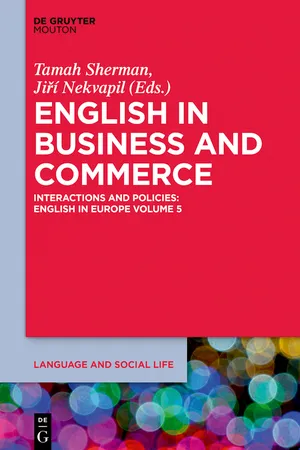
English in Business and Commerce
- 380 pages
- English
- ePUB (mobile friendly)
- Available on iOS & Android
English in Business and Commerce
About This Book
This volume fills an important gap in exploring English in the domains of business and commerce through the prism of sociolinguistics and the sociology of language, as opposed to analyzing business genres or taking a linguodidactic approach. It expands the regional coverage of English in Europe, with several studies based in Central Europe, and also considers contexts which interact with Europe even though they are physically outside of it (Asia, Africa). It addresses English as just one of several languages at play in the ecology of the countries. It focuses not only on the position of languages as declared in documents of various organizations, that is, language policy, but also everyday linguistic practices as observed in business contexts, that is, interactions. The studies are divided into three thematic areas: ideologies and discourses on English in the business sphere, the management of English in business and organizational contexts, and English and other languages on local and international labor markets. It will be of interest to readers concerned with multilingualism in the economic sphere and the workplace and the interplay between macro and micro levels during the management of communication in organizations.
Frequently asked questions
Information

Part I:Ideologies and discourses on English in the business sphere
Language standardization in sociolinguistics and international business: Theory and practice across the table
1Introduction
1.1Aims and objectives
1.2“Talking across the table”
1.3Structure of the chapter
2Standards and standardization
2.1What is standardization?
Table of contents
- Cover
- Title Page
- Copyright
- Contents
- Contributors
- Sociolinguistic perspectives on English in business and commerce
- Part I: Ideologies and discourses on English in the business sphere
- Part II: The management of English in business and organizational contexts
- Part III: The position of English and other languages on local and international labor markets, implications for language and education policy
- Index